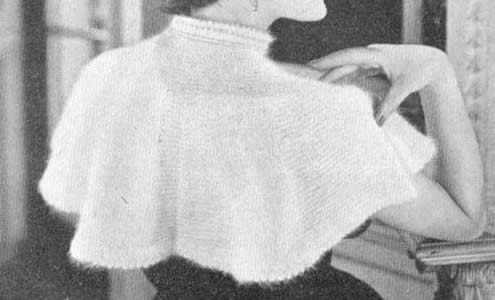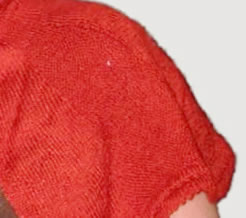Big Sister’s evening cape

A true gem of a pattern described as an "angora tippet" from the early 1950s. Originally knitted in Patons Beryl Angora 4ply wool, this version uses a mixed fibre mohair yarn which knits to a 4ply tension.
InstructionsWith No. 8 needles, cast on 338 stitches loosely, and work 4 rows stocking stitch starting with a knit row. **Next (eyelet) row: K2 *wool forward,
K2tog.; repeat from * to last 2 sts, K2. Make hem - on next row by knitting 1st from the needle together
with 1st from the cast-on edge. Work 7 rows in stocking stitch, starting
with a purl row. Repeat sections from **
to ** once more. Next row: wrong side facing, K4, *
P30, K30; repeat from * to last 34 sts; P30,
K4. Start shaping Next row: K4, (K2tog, K12) 22 times, K4. Next row: K4, (K2tog, K11) 22 times, K4. Continue in this way, decreasing 22 sts on next and every following 6th
row, (remembering you will be working 1st fewer after the K2tog on each
decrease row) until 96 sts remain. Neckband Join neckband and main body Place the needle with the neck sts and the spare needle with the body
sts together, with right sides (facing each other) together, and cast
off the two sets of stitches together. Making up
The detail shows the mixture of stocking stitch and garter stitch gored panels, which gives the shoulder cape such a perfect drape. The hem is formed by a double folded picot edging, which is reproduced at the neck.
|
MaterialsOriginal pattern calls for 2 oz angora wool. One pair each of number 8 and number 11 needles. Two decorative gold buttons, and hook and eye for fastening at the neck. Tension28st to 4 inches (10cm) on No 8 (4mm) needles. Size mattersOne size fits all! However - I did lengthen the cape by about one inch overall, as I found that although the tension was as stated in sts per inch, the length seemed shorter than depicted. A word on the woolI used a vintage wool from Pingouin called Volutes (80% acrylic 20% mohair), which I chose from my stash mainly for its rich colour. It knits to a tension of 23sts x 34rows on No. 11-12 (3-2½mm) needles, thus I knitted the cape on smaller needles than the pattern stated to achieve the right tension. I think the cape really needs to be knitted in a true luxury yarn, such as angora, or cashmere. Rowan's Kidsilk Haze could be suitable but the smallest tension on No. 10 needles is quoted as 25sts to 4in. |


